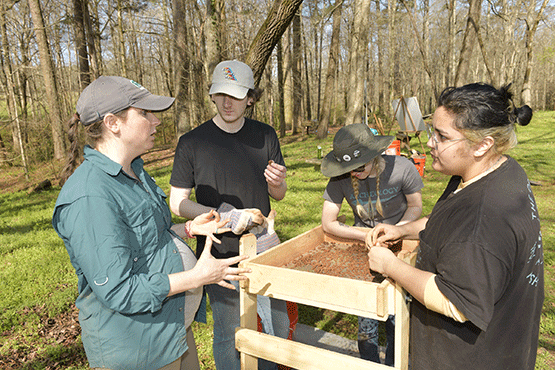news
Missing persons: Georgia Gwinnett College anthropology project pieces together lives of William Harris Homestead enslaved people

At least 18 people have gone missing on a bucolic farm 30 minutes west of Athens, and Dr. Kathryn Deeley, assistant professor of anthropology at Georgia Gwinnett College, and her students aim to find them.
The farm in question is the William Harris Homestead, a 19th-century farm owned by the same family since 1836 that's now a museum and education center. The missing people are the enslaved people owned by the Harris family, who lived and worked the farm for decades before the Emancipation Proclamation in 1863.
"We know through census data that between 1840 and 1860, the Harris family owned between 10 and 18 individuals, and they lived on the site in as few as one, and possibly as many as three, cabins," said Deeley.
The quarters where enslaved people lived were typically small and not built to last, said Deeley, so the record of these people's existence was buried over time and all but erased. Deeley and her students set out to find them in 2017, with the full support of the William Harris Homestead Museum and the Harris family.
"Unfortunately, the enslaved people's quarters are one of the things not intact on the site, which is typical for 19th-century farms," she said. "Most of them were torn down in the early 20th century because either nobody was living in them, or because the owners felt guilty for owning enslaved people."
Deeley's team started with a metal detector survey of the property, which was unsuccessful, so the next step was to simply begin digging – one hole every 10 feet, using a map hand-drawn by one of the Harris family descendants.
It's slow, methodical work. So far, 28 students and two faculty members from GGC, 14 undergraduate and two graduate students from the University of Georgia, and three volunteers from the Gwinnett Archeological Research Society have expended their time and sweat to the project over 10 total days of excavations since 2018.
Deeley said they are literally hoping to find trash – glass, dishes, animal bones, etc. – because trash piles can signal more significant archeological features like the footings of buildings.
"It's a wonderful thing about archaeology," said Deeley. "Not everybody makes it into the history books. I'm not cool enough to make it into a history book. But everybody makes trash, allowing us to recover these lost histories."
During the last dig, Deeley's students found a piece of broken dish, which might not seem like much, but it's a sign they're on the right track. She pointed out that in archaeology, even finding nothing counts as progress.
"Right now, I can tell you where the quarters weren't," she said. "And that is important."
The team finished testing the first area in which Deeley was interested in 2019 before the COVID-19 pandemic forced the project to be postponed for two years. GGC student Julia Barnett, a sophomore studying political science, joined the project when they could finally continue the search at the beginning of the 2022 school year.
"Excavations are a very intricate and invigorating process, with many precise methods and tools," said Barnett. "Dr. Deeley has been an incredible professor and mentor out in the field. Participating in the excavation on site has made me feel like I'm not only preserving history but taking part in it. I've enjoyed my time on the homestead excavation so much that I'm changing my career path and major to archaeology."
Georgeanne Eagle, a junior studying U.S. history, said working on the project has given her much more insight into the archeological process than she would learn behind a classroom desk.
"We got the full hands-on experience, learning all the techniques archaeologists use, like gridding the site and sifting for artifacts through large screens. Dr. Deeley's passion for what she does shines through in her teaching, and you can tell she genuinely enjoys passing on her bits of knowledge. I thoroughly enjoyed this tiny look into the life of an archaeologist, and think it is essential for anyone looking to study this line of work."
Deeley said she is grateful to the William Harris Homestead not just for allowing them to do this work, but for incorporating it into their presentations to the young elementary and middle-school students who come to the site.
"It's shaping a much more inclusive history."
One of Deeley's big dreams for the project is to unearth enough of the enslaved people's stories to track down descendants.
"It's a significant opportunity because most of what we know about the lives of enslaved people comes from the big plantations. Most of the 40,000 enslavers in the 19th century owned six people or less," she said. "Learning more about their lives – what kind of houses they lived in, what kind of food they ate, what kind of dishes they ate off, what did they do if they got sick – fills in the gaps. It's emotional, because these people have been forgotten, and we want them to be remembered."
Download Harris Homestead archaeology dig gallery photos.
[data-ps-embed-type=slideshow] > iframe {position: absolute;top: 0;left: 0;} _psEmbed("https://ggc.photoshelter.com");
